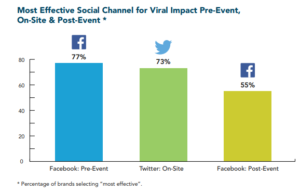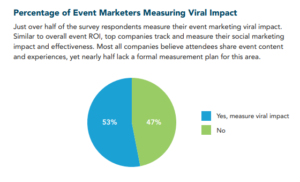Estimated Reading Time [est_time]
What I’ve learnt in the last year
Would you spend thousands of pounds investing in business cards and then leave them at the printers? I didn’t think so. This is effectively what happens when you exhibit at an event and don’t do any marketing around it.
I’ve attended a number of IT industry events over the last year, mainly to meet with existing clients, and I’ve noticed how little marketing goes on at the actual events themselves.
Surely this is a prime opportunity to engage with an audience who are on your doorstep?
It’s no secret that the majority of IT brands make sure they have a presence at most industry events and according to research carried out by Bizaboo and EventBrite
47% of C-Suite decision-makers within IT and Software organisations agree that in-person events are the most critical marketing channel to achieve key business objectives.
Not only that but
Businesses within the software & services industry invest more heavily, and more consistently in events with 42% of these allocating over 21% of their marketing budgets to events.
So why would you not follow through with a solid in-event online marketing strategy to capitalise on the opportunity you have already put your budget towards?
Pre-Event
Prior to attending the event, there are the obvious ways of promoting yourself through the event company themselves, they usually offer sponsorship packages for lanyards, show bags, networking and breakout areas and of course the show itself. These are no doubt the more costly examples of marketing and will gobble up a limited budget quickly.
Your pre-event marketing should be focused around raising awareness that you are exhibiting at the event and leveraging this to run promotions, giveaways and the offer of information and/or demos.
Social advertising
Social channels are a great way of promoting your attendance at an event to your existing network as well as letting the clients you are already working with know.
But which channel is right?
With so much choice these days it can be difficult to know which might be the right one, and if budgets are limited then you want to ensure that you are putting your budget in the most effective place.
A paid Twitter campaign allows you to target by postcode. So, in the months leading up to the event, you can target a wider location giving potential attendees time to make the necessary arrangements in order to attend. In addition to location targeting, you can use popular keywords and hashtags for the event which targets anyone tweeting, tagging and hashtagging around the event.
High profile events allow you to target people that Twitter has already identified as being interested in the event. Taking this one step further you can create lookalike audiences of your target companies’ followers through Twitter – for example, you could target a lookalike of everybody who follows the event to broaden your target audience.
LinkedIn paid advertising offers you slightly different targeting options to Twitter, so using both side by side means you could reach a well-rounded and comprehensive audience. LinkedIn targeting options could include groups, company followers as well as industries and job titles.
Another great channel for event marketing is Facebook advertising, not just because it has such a large audience but because it allows you to be incredibly specific about who exactly you wish to target. Targeting options include location, age, gender, interests, behaviours and demographics, meaning this is a popular choice with event marketers.
Once you have selected the channels that you believe are best for reaching your target audience, visiting the event pages from previous years and looking at the hashtags most commonly used is a good way of gaining attention from anyone already following the event, and therefore a potential suspect or prospect.
On the day
Most events have keynote speakers, presenters and workshop opportunities. If you have organised any of these then you need to let people know. Event attendees usually plan their days and the speakers and presentations that they want to see – if they are not aware prior to the event then it’s unlikely that they will take the time to stop by.
62% of event attendees will use their device to search for the exhibiting company whilst at the show.
Engage your audience
Marketing shouldn’t stop on the day of the event either, it’s vitally important to engage with people at the event. Social channels are again the obvious choice, using location targeting you can target a very small postcode area surrounding the event and pick up anyone who may decide to make a spontaneous decision, as well continuing to marketing to popular hashtags on the day.
According to the same study by the Event Marketing Institute (where the majority of respondents were from the technology sector) on the viral impact of events, only 36% of companies use social media to promote contests/giveaways during the event.
This seems crazy considering the hefty budget that you would no doubt have put towards whatever giveaway or offer you’re running.
Not only that but the same study showed that nearly half of the respondents fail to measure their event marketing viral impact at all.
Post Event
If this is anything to go by then I dread to think of the number of organisations failing to have a cohesive follow-up marketing strategy post-event; the same study cited that only 47% of respondents actually did any post-event marketing – meaning over half are missing out on a potentially lucrative opportunity. Post-event marketing will ensure people you may have spoken to on the day or even just people who have seen your stand from across the room, don’t forget about you.
Seize the day
Investing money on event marketing becomes redundant if you can’t retain the exposure and engagement you harnessed at the event. 53% of marketers need to realise that without post-event marketing, event marketing is only a short win and not a long term success.
So, to try and summarise what I’ve learnt in the last year of attending IT industry events it would be this: the majority of companies exhibiting are missing out on a big opportunity when it comes to marketing their presence. Marketing seems to be mainly organic and down to the individuals themselves rather than creating a cohesive event strategy covering pre-event, on the day and post-event, and attributing a budget in order to do it properly.
Budget priorities
The companies that do have a more robust strategy in place appear to not measure the engagement that their marketing actually has, meaning they are effectively throwing their money down the drain. In a world where there is so much technology at our fingertips to enable us to engage and interact with our target audience – it seems silly to not proportion part of your budget to enhance whatever you’ve already spent on the event.
If you believe you are struggling with your event marketing strategy, please feel free to reach out to a member of our team to discuss the different ways we could help.









